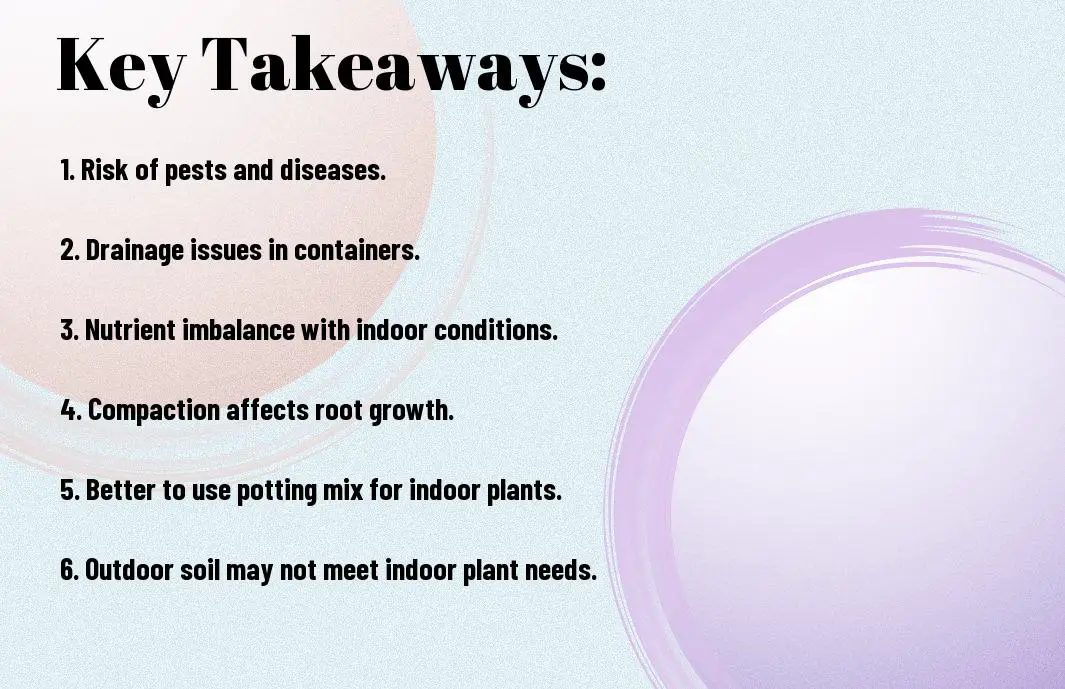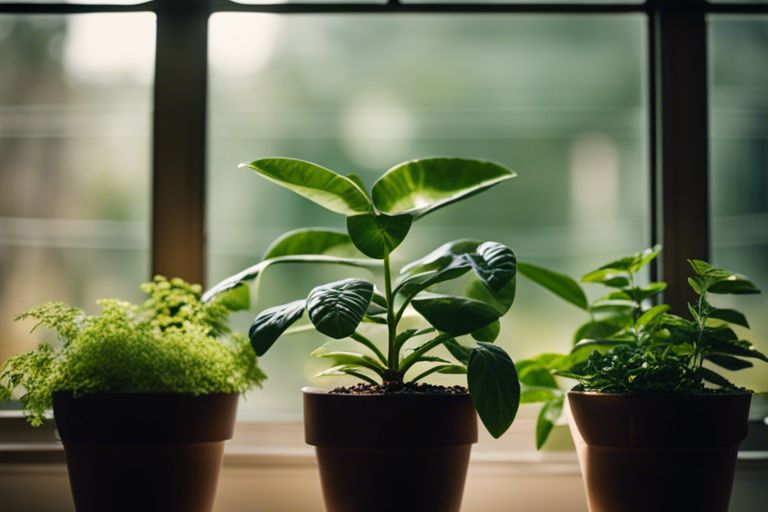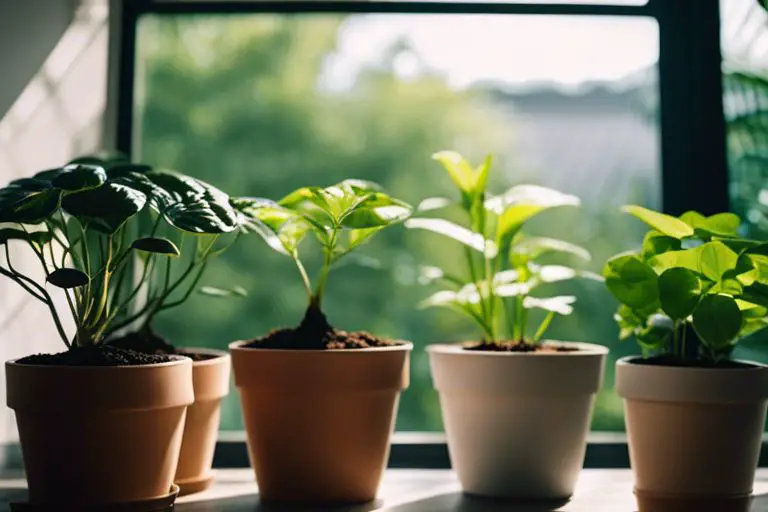#Soil composition plays a crucial role in the health and growth of indoor plants. While garden soil may seem like a convenient option for repotting indoor plants, it is not always the best choice. Garden soil tends to be heavier, retains more moisture, and can harbor pests and diseases that thrive in outdoor environments. In this blog post, we will explore the suitability of using garden soil for indoor plants, discuss potential risks, and provide alternative soil options that are more suitable for ensuring the success of your indoor garden.
Key Takeaways:
- Garden soil may not be suitable for indoor plants: Garden soil is often denser and may not provide adequate drainage for indoor plants, leading to root rot and other issues.
- Use a well-draining potting mix for indoor plants: Opt for a quality potting mix specifically formulated for indoor plants to ensure proper aeration and moisture retention.
- Consider adding amendments for indoor plants: If you prefer using garden soil, consider adding perlite, sand, or peat moss to improve drainage and create a more suitable environment for indoor plants.


Differences Between Garden Soil and Indoor Potting Mix
Texture and Density
With garden soil, you’ll find a mixture of sand, silt, and clay, which can vary greatly depending on your location. This type of soil tends to be denser and can compact easily, potentially leading to drainage issues for indoor plants. On the other hand, indoor potting mixes are specifically designed to be lighter and have better aeration, allowing roots to breathe and preventing waterlogging.
Nutrient Composition and pH Levels
Differences in nutrient composition and pH levels between garden soil and indoor potting mix can have a significant impact on the health of your indoor plants. Garden soil may not provide the right balance of nutrients needed for optimal plant growth indoors. Additionally, garden soil often has a higher pH level, which may not be suitable for certain indoor plant species that prefer more acidic conditions.
Soil pH can affect the availability of nutrients to plants. Most indoor plants thrive in a slightly acidic soil environment, typically with a pH level between 6 and 7. Indoor potting mixes are formulated to control the pH levels to create a more favorable environment for indoor plants to thrive.
Challenges of Using Garden Soil Indoors
Pest and Disease Concerns
On the surface, using garden soil for indoor plants may seem like a convenient option. However, one of the biggest challenges of doing so is the potential for introducing pests and diseases into your home. Garden soil is teeming with microorganisms, including harmful ones, that can thrive in the controlled environment of your indoor space and wreak havoc on your plants.
Drainage and Aeration Issues
An important factor to consider when using garden soil for indoor plants is the difference in drainage and aeration compared to potting mix. Garden soil tends to be denser and less well-draining than specially formulated potting mix, leading to potential issues such as waterlogging and root rot in indoor plants.
It’s crucial for indoor plants to have adequate drainage and aeration to thrive. Without proper aeration, the roots may not receive enough oxygen, which can lead to stunted growth or even plant death. Additionally, poor drainage can result in waterlogged soil, causing root rot and other root-related problems.
Alternatives to Garden Soil for Indoor Plants
Commercial Indoor Potting Mixes
Many indoor gardeners opt for commercial indoor potting mixes for their indoor plants. These pre-packaged mixes are specially formulated to provide the right blend of nutrients, aeration, and drainage for indoor plant species. With a variety of options available in stores and online, it is easy to find a mix that suits your specific plant’s needs.
DIY Soil Mix Recipes for Indoor Plants
Indoor gardeners who prefer a more hands-on approach can create their own DIY soil mix recipes for indoor plants. These DIY mixes often consist of a combination of materials such as peat moss, perlite, vermiculite, and compost. Indoor gardeners have the flexibility to adjust the mix based on the specific requirements of their plants, ensuring optimal growth and health.
Creating your own DIY soil mix for indoor plants allows you to customize the blend to cater to the specific needs of your plants. Whether your plants require a well-draining mix for succulents or a moisture-retaining mix for tropical plants, you have the freedom to tailor the soil to provide the best growing conditions.

Tips for Transitioning Outdoor Soil to Indoor Use
Not all outdoor soil is suitable for indoor plant use. Before transferring outdoor soil to indoor plants, it is important to prepare and treat the soil to ensure optimal plant growth and health. Here are some tips to successfully transition outdoor soil for indoor use:
- Inspect the soil for pests and diseases before bringing it indoors.
- Remove any weeds, rocks, or debris from the soil.
- Consider sterilizing the soil to eliminate any pathogens.
Though transitioning outdoor soil to indoor use requires preparation, it can be done successfully with the right techniques.
Sterilization Techniques
Tips for sterilizing outdoor soil for indoor use include baking the soil in the oven at 180-200 degrees Fahrenheit for 30 minutes or microwaving wet soil for 2-5 minutes. Alternatively, you can use a soil sterilizer or steam the soil to kill harmful pathogens and pests.
Amending Soil for Indoor Plant Health
Soil amendment is crucial for indoor plants to thrive. Consider adding organic matter such as compost or peat moss to improve soil structure and drainage. You can also mix in perlite or sand to increase aeration and prevent compaction, which can lead to root rot in indoor plants.
Understanding the importance of soil amendment for indoor plant health is crucial for ensuring long-term growth and vitality of your plants. By providing the right nutrients and soil structure, you can create an optimal environment for indoor plant growth.
Summing up
On the whole, using garden soil for indoor plants is not advisable due to the risk of pests, diseases, and poor drainage. Indoor plants require a lighter, well-draining potting mix specifically formulated for their needs. Garden soil may compact in a pot, leading to root rot and stunted growth. It is best to opt for a high-quality commercial potting mix suitable for indoor plants to ensure their health and vitality. Remember to always repot your plants using the appropriate soil to promote growth and thriving indoor garden.
FAQ
Q: Can I use garden soil for indoor plants?
A: It is not recommended to use garden soil for indoor plants. Garden soil may contain pests, diseases, and weed seeds that can harm your indoor plants.
Q: What type of soil should I use for indoor plants?
A: It is recommended to use a high-quality potting mix specifically formulated for indoor plants. These mixes are well-draining and provide the right balance of nutrients for indoor plants.
Q: Why is garden soil not suitable for indoor plants?
A: Garden soil is often too dense and compact for indoor plant roots to thrive. It may also lack proper aeration and drainage, leading to root rot and other issues.
Q: How often should I repot my indoor plants with new soil?
A: Indoor plants should be repotted with fresh soil every 1-2 years, or when you notice the soil has become compacted, water doesn’t drain properly, or the plant is outgrowing its pot.
Q: Can I amend garden soil to make it suitable for indoor plants?
A: While it’s possible to amend garden soil to improve its suitability for indoor plants, it’s often easier and more effective to use a high-quality potting mix designed for indoor plants. Amend with perlite, vermiculite, or sand for better drainage and aeration if you choose to use garden soil.
